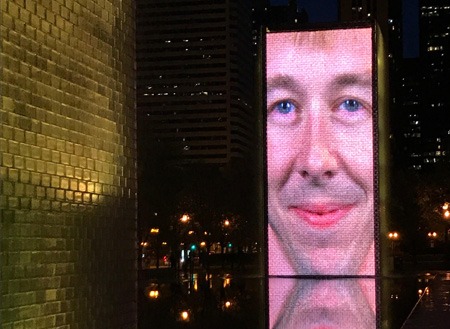
The Towering Faces In Chicago’s Millennium Park Have Had Some Work Done
August 25, 2017 by Dave Haynes
The giant LED towers in Chicago’s Millennium Park have had an upgrade, replacing the original LED set-up with newer display tech, while retaining the integrity of the iconic public art piece.
If you’ve been along Chicago’s Michigan Avenue and found you way into a sprawling downtown park, you would have seen two identical 50-foot-high glass brick towers, with a shallow pool in between. Each tower displays huge, looped videos of actual Chicagoan’s faces, with a small spout at the mouth of each face regularly “spitting” out a stream of water.
The original towers switched on in 2004, using Barco displays. The new ones are Panasonic’s – the company working with Threshold Acoustics, a Chicago-based AV consulting firm, on the refresh.
A project case study says:
Although Crown Fountain’s unique LED displays incorporated state-of-the-art technology when they were designed and implemented, LED technology has come a long way in the intervening years. In fact, the fountain itself had not been designed to exist forever without a restoration.
“Crown Fountain was actually developed in the early stages of LED technology,” says Jason Kartak, Senior Consultant at Threshold Acoustics. “Its life expectancy was only expected to be about seven to eight years, but they ended up pushing it to 13.”
By 2016, the technology was showing its age. The displays weren’t as bright—which was especially apparent on sunny days. The colors also appeared less vibrant, and the system required more frequent maintenance—a difficult task because of the way the towers are constructed.
“A lot of diodes and modules were running out,” says Dagan Pratt, Project Manager at Panasonic. “It was time for a refresh.”
From the get-go, Panasonic and its partners knew that their biggest challenge would be upgrading Crown Fountain while preserving the integrity of Plensa’s vision. It had already been determined that the overall look of the fountains would be unchanged. That also meant that the resolution (measured in pixel pitch) could not be significantly increased.
“It was a very difficult project, because you have to work within the constraints of the existing fountain,” says Kartak. “At the same time, to meet the artistic aspect, we had to keep certain characteristics of the old LED wall. We needed to keep the pixel pitch very similar to preserve the artist’s intent.”
Another challenge had to do with the fountain’s function itself. Though the LED panels are separated from the water by the glass bricks, and the LEDs themselves are water-resistant, there was still the matter of finding a way to fit the new LED panels around the “spitting” feature, which the architects refer to as the “gargoyle.”
“This was a tough challenge, because you need to have the panels recessed around the mouth, where the water spits out, but not in such a way that it’s visible to patrons,” says Kartak.
To accomplish this, Panasonic’s engineers combined a custom frame area with reflective mirror tape—crafting a solution that not only served its intended purpose, but also appeared seamless to visitors.
The new system is touted as 25% more energy-efficient, twice as bright, equipped with light sensors (to auto dim on sunny days), and much better in terms of color reproduction.



Leave a comment